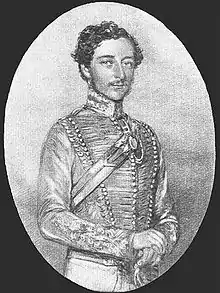Charles John Stanley Gough
General Sir Charles John Stanley Gough VC, GCB (/ˈɡɒf/; 28 January 1832 – 6 September 1912) was a senior British Indian Army officer and a recipient of the Victoria Cross, the highest award for gallantry in the face of the enemy that can be awarded to British and Commonwealth forces.
Sir Charles John Stanley Gough | |
|---|---|
 A young Gough, circa 1850, in the uniform of the 8th Bengal Light Cavalry | |
| Born | 28 January 1832 Chittagong, India |
| Died | 6 September 1912 (aged 80) Clonmel, County Tipperary, Ireland[1] |
| Buried | St Patrick's Cemetery, Clonmel |
| Allegiance | United Kingdom |
| Service/ | Bengal Army British Indian Army |
| Years of service | 1848–18?? |
| Rank | General |
| Battles/wars | Second Anglo-Sikh War Indian Mutiny Bhutan War Second Anglo-Afghan War |
| Awards | Victoria Cross Knight Grand Cross of the Order of the Bath |
| Relations | Sir Hugh Gough (brother) Sir Hubert Gough (son) Sir John Gough (son) |
Early life
Gough as born into an Anglo-Irish aristocratic family in Chittagong, Bengal, British India, on 28 January 1832.
Details
At age 16, Gough moved back to India, joined the 8th Bengal Cavalry, and served through the Second Anglo-Sikh War.[2] By the age of 25, Gough was a major in the 5th Bengal European Cavalry.
During the Indian Mutiny, Gough and his brother Hugh were members of the Guides Corps, where they took part in the Siege of Lucknow and Gough was awarded the Victoria Cross (VC) for deeds which included saving his brother.[2] The award was announced on 21 October 1859, and the citation read:
5th Bengal European Cavalry, Major Charles John Stanley Gough
Date of Acts of Bravery, 15th and 18th August, 1857, and 27th January, and 23rd February, 1858
First, for gallantry in an affair at Khurkowdah, near Rhotuck, on the 15 August 1857, while serving with Hodson's Horse, in which he saved his brother, who was wounded, and killed two of the Enemy.
Secondly, for gallantry on 18 August, when he led a Troop of the Guide Cavalry in a charge, and cut down two of the Enemy's Sowars, with one of whom he had a desperate hand to hand combat.
Thirdly, for gallantly on 27 January 1858, at Shumshabad, where, in a charge, he attacked one of the Enemy's leaders and pierced him with his sword, which was carried out of his hand in the melee. He defended, himself with his revolver, and shot two of the Enemy.
Fourthly, for gallantry on 23 February, at Meangunge, where he came to the assistance of Brevet-Major O. H. St. George Anson, and killed his opponent, immediately afterwards cutting down another of the Enemy in the same gallant manner.[3]
During the Second Anglo-Afghan War, he led a relief column to relieve the Siege of the Sherpur Cantonment, on which news Mohammed Jan ordered an assault on the garrison, which failed before he arrived.
Family
He was the son of Judge George Gough and Charlotte Margaret Becher; brother of General Sir Hugh Gough; father of General Sir Hubert Gough and Brigadier General Sir John Gough; and greatnephew of Field Marshal The 1st Viscount Gough. He later achieved the rank of general.[4]
The Medal
His VC is on display in the Lord Ashcroft Gallery at the Imperial War Museum, London.[5]
References
- "thePeerage.com". Retrieved 6 May 2009.
- Chisholm, Hugh (1913). The Britannica Year Book. The Encyclopædia Britannica Company. p. 548.
Charles John Stanley Gough.
- "No. 22318". The London Gazette. 21 October 1859. p. 3792.
- "No. 26519". The London Gazette. 5 June 1894. p. 3257.
- "Lord Ashcroft VC collection". Retrieved 4 March 2013.
